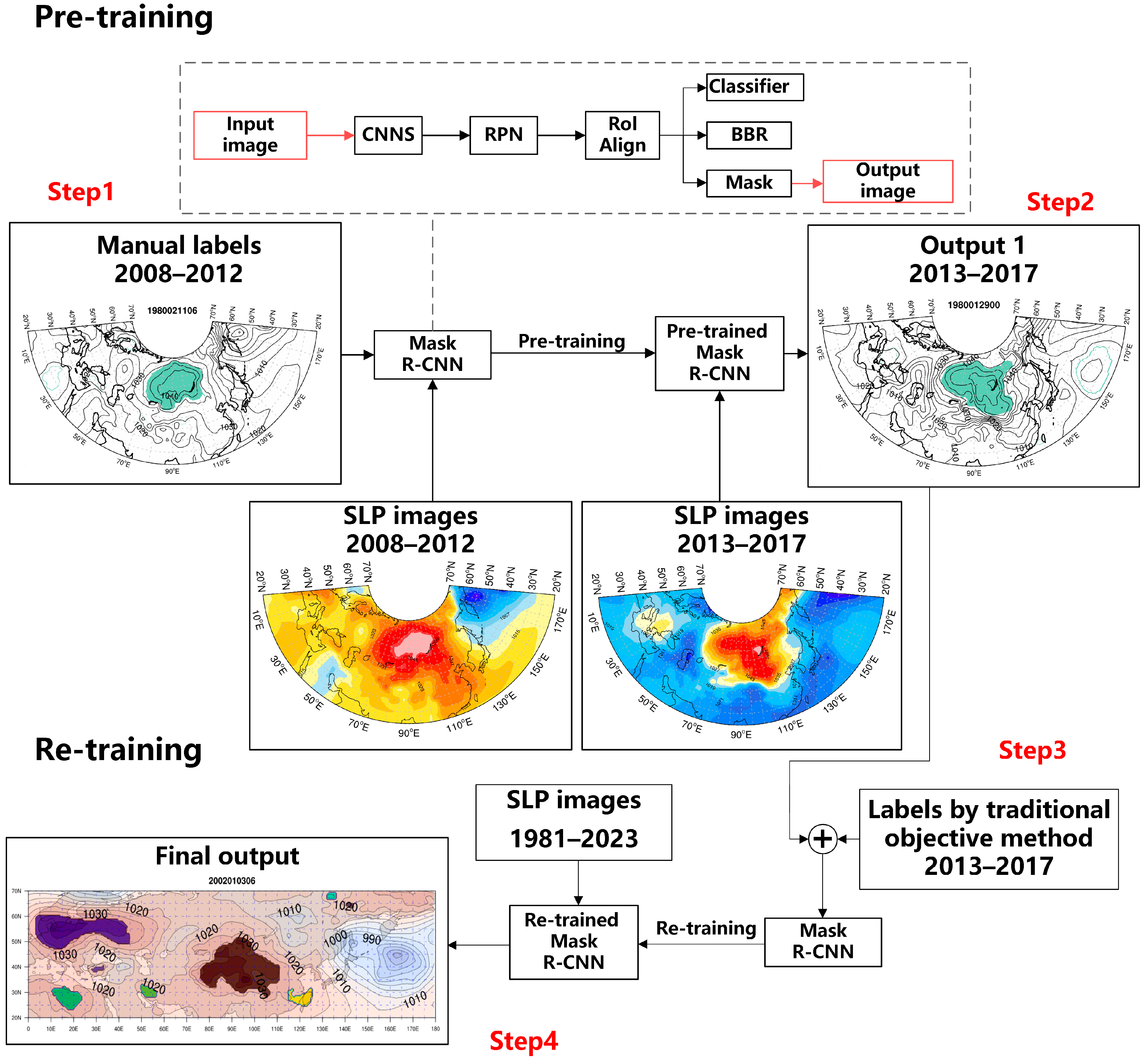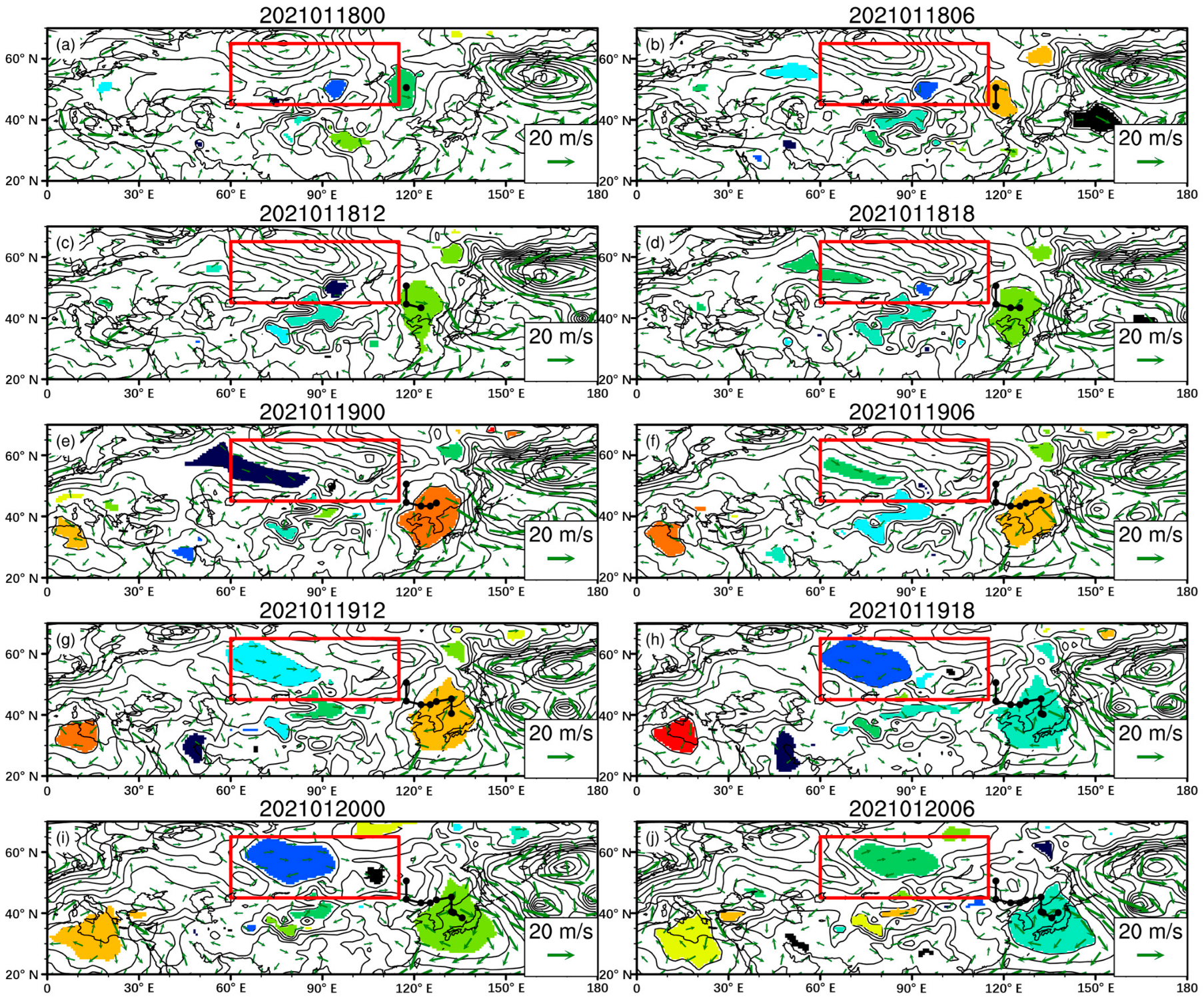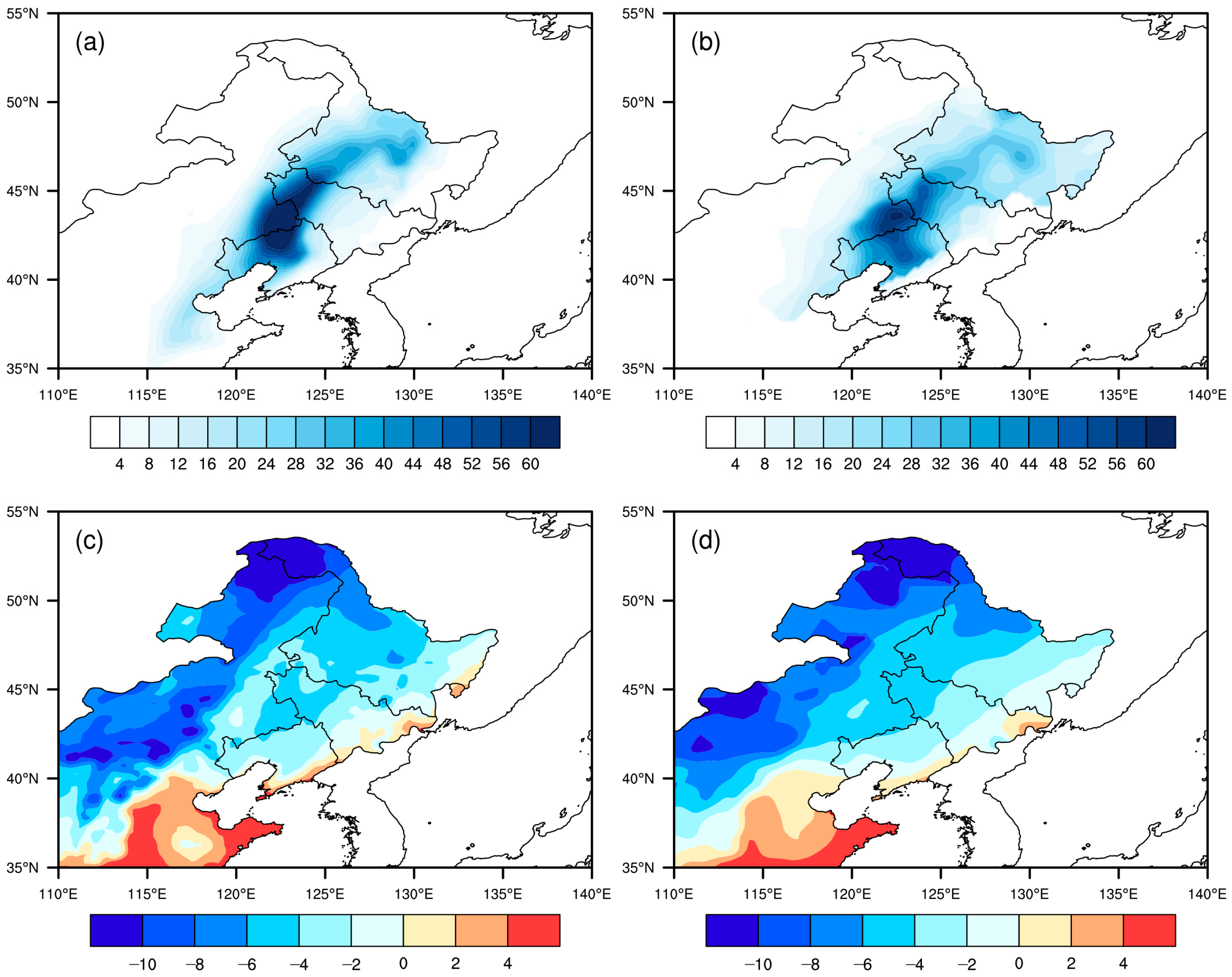A New Anticyclone Identification Method Based on Mask R-CNN Model and Its Application
Abstract
1. Introduction
2. Data and Methods
2.1. Data
2.2. Methods: The New Anticyclone Identification Method Based on Mask R-CNN Model
- (1)
- Manual annotation: Manual analysis and identification were conducted for major anticyclone systems over the Mongolian Plateau region (40–55° N, 80–120° E) during winter seasons from 2008 to 2012. Specifically, the field of SLP over Eurasia (20–70° N, 0–180° E) at each timestamp was plotted as a figure, comprising 72 × 256 grid points. Then, according to the spatial distribution of SLP, the outermost SLP value of a single high-pressure system over the Mongolian Plateau region was manually determined to identify anticyclone systems with closed isobars. All grid points enclosed by the outermost closed isobar of each system were designated as the anticyclone’s influence area (for further methodological details, please refer to Zhang et al. [17]). This process generated a manually labeled dataset of anticyclone systems in these five years in winter, including their positions, shapes, and influence areas (manual labels shown in Figure 1, i.e., the dataset used for pre-training the Mask R-CNN model in step 2). Statistically, a total of 1671 anticyclones were manually annotated over the Mongolian Plateau during the winters from 2008 to 2012.
- (2)
- Mask R-CNN model pre-identification (that is, the pre-training phase illustrated at the top of Figure 1): The manually labeled 5-year anticyclone data were used to train the Mask R-CNN model. In this study, a GPU parallel computing architecture was employed, with the batch size set to 4, the number of epochs set to 30, the number of classes set to 2 (i.e., anticyclone and background), and the field of SLP over Eurasia at each timestamp was extracted and normalized into a grayscale image, with a size of 72 × 256 pixels by using the formula.where g′ indicates the normalized SLP of each point or pixel, g denotes the original SLP of each point or pixel (unit: hPa), and Gmin and Gmax indicate the maximum and minimum values, respectively, within the SLP field of each timestamp. The grayscale normalization does not adversely affect identification, as anticyclones are typically represented as regions of higher SLP. In this study, brighter areas in the grayscale images generally correspond to anticyclones, which are distinct from the darker regions representing other meteorological features. Then, the model was initialized using pre-trained weights from the COCO dataset. The grayscale images and 5-year manual labels were used as inputs, leveraging transfer learning to enhance its capability for anticyclone detection. The number of steps per epoch was set to 10,000, and the validation steps were set to 5000 to mitigate overfitting. Finally, the fields of SLP (i.e., grayscale images) from 2013 to 2017 were input to the trained model to obtain the corresponding anticyclone identification results for each timestamp (expanded labels shown in Figure 1, i.e., one dataset used for re-training the Mask R-CNN model in step 4). Additionally, to ensure identification accuracy, only anticyclone detection results with a confidence level greater than 80% were retained.
- (3)
- Objective identification: Since manual identification focused on labeling large-scale anticyclones significantly impacting the Mongolian Plateau and surrounding areas, an objective weather system identification algorithm was additionally applied in this study to increase the number of anticyclone samples. This algorithm processes the SLP data directly to identify anticyclonic systems over Eurasia (20–70° N, 0–180° E), without the need for image conversion, a key distinction from deep learning-based methods. It locates the anticyclones by detecting the SLP maximum points on the original SLP data, and determines their area by searching the outer contour lines outward. For further methodological details, please refer to Lu [30]. This procedure generated another labeled anticyclone dataset using a traditional objective method, providing one of the inputs for re-training the Mask R-CNN model (labels by traditional objective method shown in Figure 1).
- (4)
- Mask R-CNN model re-training, and anticyclone re-identification: The anticyclone labels obtained from Step 2 (i.e., the results of Mask R-CNN model pre-trained by manual annotation) and Step 3 (i.e., the results of traditional objective methods), covering the period from 2013 to 2017, were integrated into a new anticyclone training dataset. Specifically, when two anticyclone labels overlapped, their union was taken as the new anticyclone label, and when one label entirely contained another, the larger-scale label was regarded as the new anticyclone label.
3. Results
3.1. The Performance of the New Identification Method
3.2. The Application of the New Identification Method
3.2.1. Tracking the Development and Evolution of Anticyclones
3.2.2. Evolution Characteristics of an Anticyclone During a Cold Wave Event
3.3. The Relationship Between Anticyclone and Regional Abnormal Cooling
4. Conclusions and Discussion
- (1)
- Compared with the identification results by the traditional objective method, this method effectively detects anticyclones that more accurately represent their comprehensive structural characteristics. Statistically, the average matching radio from 2008 to 2012 was 95.2%. It robustly identifies large-scale, intense anticyclones that substantially influence synoptic-scale weather conditions and are consistently linked to well-defined anticyclonic circulation patterns, especially for anticyclones over Siberia and Mongolia.
- (2)
- The anticyclone systems identified and tracked by this new method effectively characterize the development and movement trajectories of cold-air activity, offering significant indicative value for cold wave processes and severe weather events such as abrupt cooling and snowfall. Applied to the 7–9 November 2021 cold wave case, this method detected anticyclone precursor activity originating near the Ural Mountains on 2 November, followed by continuous southeastward extension and propagation. The system persisted over southern Siberia and upstream regions of Northeast China during 6–9 November, inducing widespread drastic cooling across Northeast and North China. For the cold wave case occurring from December 12 to 14, 2023, a significant anticyclone activity was also detected in the preceding period. These results demonstrate the method’s capability to infer cold-air development and cold wave evolution through the identification and tracking of anticyclone dynamics and cold high characteristics, thereby providing critical technical support for weather forecasting, traffic management optimization, and early warning decisions in northern Chinese cities.
- (3)
- Further analysis reveals significant associations between Siberian anticyclone activity and downstream temperature (or CAM) variations in China’s North, Central, and East regions. During the winter of 1981/1982–2022/2023, Siberian High events occurred at an average frequency of 109 occurrences annually, with downstream 24 h CAM enhancement and cooling observed concurrently on 60% of event days. The time series of Siberian High influence days showed strong correlations with regional CAM enhancement (r = 0.88) and cooling (r = 0.92), both statistically significant (p < 0.01). Additionally, a significant negative correlation (r = −0.86, p < 0.01) exists between 24 h cooling magnitude and anticyclone-transported CAM enhancement. These results confirm the important influence of Siberian anticyclone activity on downstream CAM accumulation and regional cooling, which is closely related to cold-air activity and winter cold wave processes.
Author Contributions
Funding
Institutional Review Board Statement
Informed Consent Statement
Data Availability Statement
Conflicts of Interest
Abbreviations
| CNN | Convolutional neural network |
| Mask R-CNN | Mask region-based convolutional neural network |
| SLP | Sea level pressure |
| CAM | Cold air mass |
References
- Guirguis, K.; Gershunov, A.; Schwartz, R.; Bennett, S. Recent warm and cold daily winter temperature extremes in the Northern Hemisphere. Geophys. Res. Lett. 2011, 38, L17701. [Google Scholar] [CrossRef]
- Cohen, J.L.; Furtado, J.C.; Barlow, M.A.; Alexeev, V.A.; Cherry, J.E. Arctic warming, increasing snow cover and widespread boreal winter cooling. Environ. Res. Lett. 2012, 7, 014007. [Google Scholar] [CrossRef]
- Wang, L.; Chen, W. The East Asian winter monsoon: Re-amplification in the mid-2000s. Chin. Sci. Bull. 2014, 59, 430–436. [Google Scholar] [CrossRef]
- Lu, C.; Xie, S.; Qin, Y.; Zhou, J. Recent Intensified Winter Coldness in the Mid-High Latitudes of Eurasia and Its Relationship with Daily Extreme Low Temperature Variability. Adv. Meteorol. 2016, 2016, 3679291. [Google Scholar] [CrossRef]
- Peng, J.; Sun, S.; Chen, B. Maintenance and development of Ural blocking high and its relationship with severe cold wave activities in 2020/2021 winter. Chin. J. Atmos. Sci. 2023, 47, 1421–1433. (In Chinese) [Google Scholar]
- Gao, Q.; Jin, W.; Gao, Q.; Xu, Q.; Tian, L.; Liu, D.; Han, G. Diagnostic analysis of the extreme rain-snow process in Liaoning province from November 7–9, 2021. J. Meteorol. Environ. 2024, 40, 1–8. (In Chinese) [Google Scholar] [CrossRef]
- Ioannidou, L.; Yau, M.K. A climatology of the Northern Hemisphere winter anticyclones. J. Geophys. Res. Atmos. 2008, 113, D08119. [Google Scholar] [CrossRef]
- Zhang, X.; Lu, C.; Guan, Z. Weakened cyclones, intensified anticyclones and recent extreme cold winter weather events in Eurasia. Environ. Res. Lett. 2012, 7, 044044. [Google Scholar] [CrossRef]
- Lu, C.; Zhang, Y.; Guan, Z. Winter anticyclone activities in Siberia and their relationship to the regional temperature anomaly. Int. J. Climatol. 2022, 42, 6293–6310. [Google Scholar] [CrossRef]
- Qin, Y.J.; Lu, C.H. Characteristics of the anticyclone over Eurasia and its relationship with the winter temperature in China. Trans. Atmos. Sci. 2017, 40, 418–424. (In Chinese) [Google Scholar]
- Zhi, X.; Tian, X.; Liu, P.; Hu, Y. Interdecadal variations in winter extratropical anticyclones in East Asia and their impacts on the decadal mode of East Asian surface air temperature. Meteorol. Atmos. Phys. 2019, 131, 1763–1775. [Google Scholar] [CrossRef]
- LeCun, Y.; Bengio, Y.; Hinton, G. Deep learning. Nature 2015, 521, 436–444. [Google Scholar] [CrossRef] [PubMed]
- He, K.; Gkioxari, G.; Dollár, P.; Girshick, R. Mask r-cnn. In Proceedings of the IEEE International Conference on Computer Vision, Venice, Italy, 22–29 October 2017; pp. 2961–2969. [Google Scholar] [CrossRef]
- Kirillov, A.; He, K.; Girshick, R.; Rother, C.; Dollár, P. Panoptic segmentation. In Proceedings of the IEEE/CVF Conference on Computer Vision and Pattern Recognition, Long Beach, CA, USA, 15–20 June 2019; pp. 9404–9413. [Google Scholar] [CrossRef]
- Hong, S.; Kim, S.; Joh, M.; Song, S.K. Globenet: Convolutional neural networks for typhoon eye tracking from remote sensing imagery. arXiv 2017, arXiv:1708.03417. [Google Scholar] [CrossRef]
- Lu, C.H.; Kong, Y.; Guan, Z.Y. A Mask R-CNN model for reidentifying extratropical cyclones based on quasi-supervised thought. Sci. Rep. 2020, 10, 15011. [Google Scholar] [CrossRef]
- Zhang, Y.; Lu, C. Detection of the synoptic southeastward-extending Siberian cold high during 1978–2017. Atmos. Ocean. Sci. Lett. 2022, 15, 100140. [Google Scholar] [CrossRef]
- Kong, Y.; Lu, C.; Guan, Z.; Chen, X. Comparison of intense summer arctic cyclones between the marginal ice zone and central arctic. J. Geophys. Res. Atmos. 2024, 129, e2023JD039620. [Google Scholar] [CrossRef]
- Qin, Y.; Liu, Q.; Lu, C. Cold Front Identification Using the DETR Model with Satellite Cloud Imagery. Remote Sens. 2024, 17, 36. [Google Scholar] [CrossRef]
- Abdulla, N.; Demirci, M.; Ozdemir, S. Design and evaluation of adaptive deep learning models for weather forecasting. Eng. Appl. Artif. Intell. 2022, 116, 105440. [Google Scholar] [CrossRef]
- Bochenek, B.; Ustrnul, Z. Machine learning in weather prediction and climate analyses—Applications and perspectives. Atmosphere 2022, 13, 180. [Google Scholar] [CrossRef]
- Zhou, K.; Zheng, Y.; Li, B.; Dong, W.; Zhang, X. Forecasting different types of convective weather: A deep learning approach. J. Meteorol. Res. 2019, 33, 797–809. [Google Scholar] [CrossRef]
- Chen, L.; Han, B.; Wang, X.; Zhao, J.; Yang, W.; Yang, Z. Machine learning methods in weather and climate applications: A survey. Appl. Sci. 2023, 13, 12019. [Google Scholar] [CrossRef]
- Higgins, T.B.; Subramanian, A.C.; Graubner, A.; Kapp-Schwoerer, L.; Watson, P.A.; Sparrow, S.; Kashinath, K.; Kim, S.; Monache, L.D.; Chapman, W. Using deep learning for an analysis of atmospheric rivers in a high-resolution large ensemble climate data set. J. Adv. Model. Earth Syst. 2023, 15, e2022MS003495. [Google Scholar] [CrossRef]
- Ghada, W.; Estrella, N.; Menzel, A. Machine learning approach to classify rain type based on Thies disdrometers and cloud observations. Atmosphere 2019, 10, 251. [Google Scholar] [CrossRef]
- Kalkan, M.; Bostancı, G.E.; Güzel, M.S.; Kalkan, B.; Özsarı, Ş.; Soysal, Ö.; Köse, G. Cloudy/clear weather classification using deep learning techniques with cloud images. Comput. Electr. Eng. 2022, 102, 108271. [Google Scholar] [CrossRef]
- Deng, J.; Dong, W.; Socher, R.; Li, L.J.; Li, K.; Fei-Fei, L. Imagenet: A large-scale hierarchical image database. In Proceedings of the 2009 IEEE Conference on Computer Vision and Pattern Recognition, Miami, FL, USA, 20–25 June 2009; pp. 248–255. [Google Scholar] [CrossRef]
- Ren, S.; He, K.; Girshick, R.; Sun, J. Faster r-cnn: Towards real-time object detection with region proposal networks. IEEE Trans. Pattern Anal. Mach. Intell. 2016, 39, 1137–1149. [Google Scholar] [CrossRef]
- Hersbach, H.; Bell, B.; Berrisford, P.; Hirahara, S.; Horányi, A.; Muñoz-Sabater, J.; Nicolas, J.; Peubey, C.; Radu, R.; Schepers, D.; et al. The ERA5 global reanalysis. Q. J. R. Meteorol. Soc. 2020, 146, 1999–2049. [Google Scholar] [CrossRef]
- Lu, C.H. A modified algorithm for identifying and tracking extratropical cyclones. Adv. Atmos. Sci. 2017, 34, 909–924. [Google Scholar] [CrossRef]











Disclaimer/Publisher’s Note: The statements, opinions and data contained in all publications are solely those of the individual author(s) and contributor(s) and not of MDPI and/or the editor(s). MDPI and/or the editor(s) disclaim responsibility for any injury to people or property resulting from any ideas, methods, instructions or products referred to in the content. |
© 2025 by the authors. Licensee MDPI, Basel, Switzerland. This article is an open access article distributed under the terms and conditions of the Creative Commons Attribution (CC BY) license (https://creativecommons.org/licenses/by/4.0/).
Share and Cite
Kong, Y.; Wu, H.; Xia, P.; Zhang, Y. A New Anticyclone Identification Method Based on Mask R-CNN Model and Its Application. Atmosphere 2025, 16, 1140. https://doi.org/10.3390/atmos16101140
Kong Y, Wu H, Xia P, Zhang Y. A New Anticyclone Identification Method Based on Mask R-CNN Model and Its Application. Atmosphere. 2025; 16(10):1140. https://doi.org/10.3390/atmos16101140
Chicago/Turabian StyleKong, Yang, Hao Wu, Ping Xia, and Yumin Zhang. 2025. "A New Anticyclone Identification Method Based on Mask R-CNN Model and Its Application" Atmosphere 16, no. 10: 1140. https://doi.org/10.3390/atmos16101140
APA StyleKong, Y., Wu, H., Xia, P., & Zhang, Y. (2025). A New Anticyclone Identification Method Based on Mask R-CNN Model and Its Application. Atmosphere, 16(10), 1140. https://doi.org/10.3390/atmos16101140





